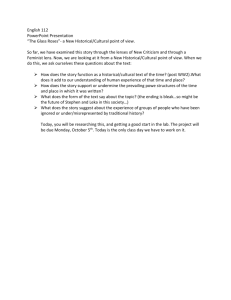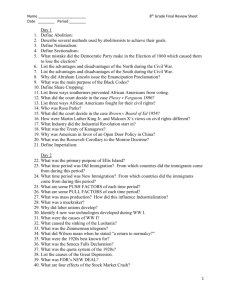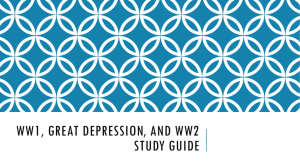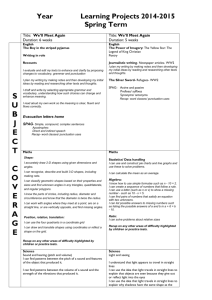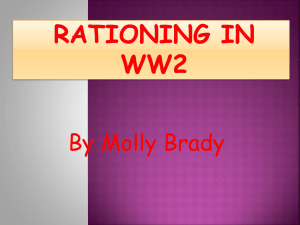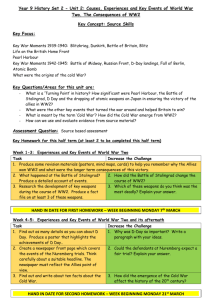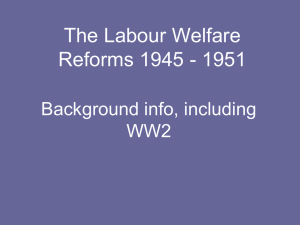The Sociology of the family
advertisement
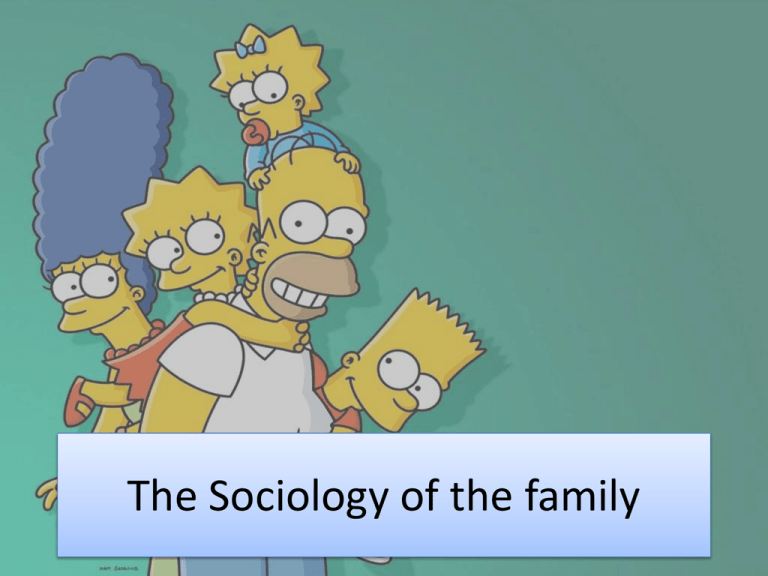
The Sociology of the family Todays lesson (C 1.1) Next lesson (C2.1, 2.2) All about changes to structure of the family ! Third lesson (3.1, 3.2) All about the changing roles within the family ! • Discussing the • Discuss how the changes that have roles of the family taken place in the have changed structure of the since WW2 family since WW2 Should: outline the • Evaluate two two perspectives in • Analyse two competing relation to he explanations for sociological views family’s role in the these changes on the social structure significance of these changes for Could: compare and the family. contrast these perspectives Must: Identify two perspectives of the role of the family Getting you thinking- 10 minutes • In pairs create a mind map with the ‘thought bubble’ being labelled as, • ‘the family- what is it , and what does it give us? What is the role/ function of the family? • The family is a social group characterised by common residence, economic cooperation and reproduction . It includes adults of both sexes, at least two of whom maintain social approved sexual relationship, and one of more children, own or adopted, of the sexually cohabitating adults’ (Murdock 1949). • We will analyse the structure later! (C2) The role of the family: functionalist perspective • First have a think on how functionalist would see the role of the family? • What benefits does the family offer on a society level? • Board mind map task Functionalist: with supported handout Emotional support. Practical support Socialisation Functionalist Social Identity Regulate sexual activity and reproduction: biological consequences However • Murdock's definition of the family is an ‘happy’ one, does not take into account that not everyone has a positive experience of the role of the family. ( children who are neglected) • Functionalism also forgets that other factors have an impact on the role of the family. For example, social class. • What do you think to the above statement Extreme example • The Ik culture • Lastly • However does not take into account the way family may contribute to social inequality… • Have a chat in pairs analysing the above statement • Reflect on board Marxist perspective on the role of the family • Handout • Group discussion- linking to assessment However: Marxist • There are some benefits to the family • see Functionalism! Lesson 2 12th May 2015 Structure and roles of the family since WW2 till now The role OF the family: Functionalist • Socialisation • Emotional/physical support • Parsons –personality factories – children committed to shared norms, values and feelings of belongingness to society • Relieve the stress of modern day living : Warm bath theory (handout) • Family provides a relaxing place for the worker after a hard day of work… Marxist • Socialisation is a tool used by capitalist society Other critiques: • Functionalist explanation of the family based on middle class ideology • Ignores divorce rates, domestic abuse, and childhood neglect- not all rosy and happy family life. The role OF the Family The Structure of the family The roles WITHIN the family C 1.1/1/2 Defining the role Compare and contrast functionalist and Marxist perspectives on this C2.1/2/2 Changes to the structure since WW2 Analyse functionalist and Marxist explanations for these changes C3.1/3.2 Changes to the role within the family since WW2 and evaluate functionalist and Marxist perspectives of the importance of these changes The structure of the family today • In order to appreciate the changes to the structure and roles within the family that has taken place since the industrial revolution and WW2, we need to analyse what the structure and roles of the family today… • Task- mindmap Structure of family today • Heterosexual/Homosexual • Single parent –mother or father • Families with no children • None, one or both parents working • Divorced households • Children not always biological • Less children: •There were 7.7 million families with dependent children in the UK in 2012, 1 in 7 of which had three or more dependent children. •Married couples had a higher average number of dependent children in their family than other family types, at 1.8 children per family compared with 1.7 on average. •Nearly 9 in 10 couple families with three or more dependent children had either one or both parents working (ONS, 2012) Roles within the family today: UK based • Role of the child: • Role of the woman: • Role of the man: What you need to consider… • How did the current structure of the family become the way it is now.. How was it before WW2 (industrial revolution) • How was it before this period? • Why does the structure of the family change? (two perspectives) • What influences these changes in both structure and the roles within the family (two perspectives)? Getting you thinking task (p40) • Introduction to criteria 2 • Mind map refresher: what do we remember about a pre industrial society? The family Pre WW2 (Pre industrialisation The roles and structure of the preindustrial family : Ascribed social class • High death rate particularly of children, made it necessary to raise up a dozen children • Mothers taught daughters domestic activities • Fathers would teach sons manual labour • Families raised their children strictly to work • Father was the head of the family • Each individual family played an important role in society • The men were raised to work and make money • Women were raised to protect their family and territory due to absence of proper law, women had to be able to fight to protect their land whilst the man was working • Any similarities to today’s family? Phillippe Aries (1962): the role of children • • • • • • • Handout: p56 Childhood today is a recent social invention Childhood in this time did not exist Children were little adults Economic asset Rather then a symbol of love Investing emotionally into children was difficult as death rates were so high • Unit of production • Children expected to help in this. Remember ‘Enlightenment’ happened which led to industrialisation.. • http://www.bbc.co.uk/bitesize/ks3/history/in dustrial_era/the_industrial_revolution/video/ The industrial revolution!! (1790s onwards) and now the achieved society (for men) Parsons (Functionalist) (Parsons and Bales, 1956) • Functionalists argue that family develop to meet the basic needs of societies • The family due to industrial revolution lost most of it’s jobs which led the family change its role to that of socialisation (to fit with society's’ changes) • Which had long lasting effects and seen even today… Parson’s continued • Lets break his theory down: • The industrial revolution brought about 3 important changes to the family Lets analyse the structure of ‘The Simpsons’. 1. The nuclear family • The nuclear family: is a family structure that consists of two parents living with their 2/3 children, also known as an immediate family and married (values and morals) • This was the ideal because easier to move for job opportunities as society changed from an ascribed to an achieved state 2. Introduction of specialised agencies • These took over the many functions of the family for example: • Health, welfare and education (further promoting, longer life, less child deaths, and meritocracy- hence further changing the structure of the family to nuclear!!) • Children became centre of the family – socialisation was promoted 3. Division of labour • Division of labour • Men: breadwinners- role is to provide financially for the family, act as the disciplinary role model for children • Women: housewives and motherhoodnurturing roles, looking after the house, having more children (housework) The children's’ role changed too… but slower from 1800s-early 1900s • Not at first: children were still expected to work in factories, mines and mills until late 1800s • However attitudes from the new middle class (meritocratic based) started to change: growth in love and especially as the mortality rate lowered. • Middle of 19th century: children excluded from mines and factories where 1000s had been killed. However resistance was from the working class, as children's’ wages were needed- until laws were enacted to give a minimum wage. • Other polices arose: education and sexual consent (early 1900s), children were no longer being sold for sex (SC 16) • Children became protected • They were recognised as important • They were educated to fit into an meritocratic and industrialised society… An example: Education • An 1880 Act made education compulsory until the age of ten, following campaigning by the National Education League. Under the Elementary Education (School Attendance) Act 1893 it was increased to 11 and the right to education was extended to deaf and blind children. In 1899 the leaving age was increased again to 13. Parsons concluded: • The nuclear family was the most effective in providing achievement –orientated and geographically mobile workforce required for modern societies.. • As the most apt to meet the needs of societyto get their young socialised. However: Parsons However • Is this our family now- nuclear? • Or did something else happen to change the roles and structure? WW2 happened • Things to consider: • How did WW2 affect the family? (as it was happening) • Did the structure change again? • Did the roles within the family change again? WW2 and its affect on the family • Handout: http://www.bbc.co.uk/history/british/britain_ wwtwo/women_at_war_01.shtml • Class building mind-map task The roles of children in WW2 • The Children: encouraged to leave their homes • Encouraged to play more even on bomb sites The changes • The roles within family: • • The structure of the family: After the war • Women were encouraged to return to the home to have babies to replenish the UK population after WW2 • Led to the second baby boom of the 1950s • Because women were made to stay at homepolicies were enacted – for example, • No free childcare was needed for the mother to work • Women were dismissed from their posts Lesson 3 THE SOCIOLOGY OF THE FAMILY Assignment brief Recap: Roles of the family • • • • • • The roles of the family is to provideEmotional support Physical support Socialisation- teaches us morals, role, values etc Our understanding of Social class The bath tub theory- family a place to relax after a hard day’s work! • However- Marxist – way to keep us under control, not all families have the experience! This we worked out on the board as a mindmap! Recap-changing structure and roles within the family • Before industrialisation the family was extended with each member having a role- IE children- ‘little adults’ • After industrialisation the family became Nuclearleading up to WW2- birth of institutions led to ‘love’ of our children/ set roles within the family- The Simpsons • WW2 changed family: single parents, co-habiting vs marriage, working women- (Barrow (2010) 90 per-cent of women were employed), conducting jobs that were normally male dominated, single parent families etc • Since WW2 other changes : Homosexuality legal, divorce rates, families with no children, contraception, women being the ‘breadwinner’ , mixed heritage families – leading to how our family is today • What is the impact of this? Changing family roles and structure since WW2 Since WW2 Women- breadwinners vs housewives • Change to the roles within the family • From 1940-1945, the female labor force grew by 50% and female employment in defense industries grew by 462%” (AllAboutHistory.org). This also shifted cultural attitudes, making it okay for middle class women to work, where previously it had been taboo • http://www.bbc.co.uk/bites ize/standard/history/scotlan d_britain_1880_now/emplo yment_women/revision/4/ video • Handout: • Lots of women had to keep working (husbands died) • Demanded to keep working • Skills leant were needed • However they were paid less then men And Today?... • Women in leadership roles • Rise of the contraceptive pill: women can have many partners thus women are not the role seen in the nuclear family. • Women CHOSE to have children • To CHOSE their sexuality maybe? • Chose when to have children • Hence the role of the woman is not always just being a mother. • Will have an impact on the structure! • As the change to a role within the family will change the structure of the family Since WW2: Birth of Contraception: changes to roles within and structure of the family • Effects both structure: less children • Roles: women can choose not to procreatethey are no longer the house wife/mother. Since WW2 change to Marriage and cohabiting • Getting you thinking task: page 48 • Change to the structure (challenges nuclear) • Because of the 1960s- people now chose if they want to get married or not… • About 15.2 per cent of families consist of a married couple with children • Is 300,000 fewer than a decade ago • Handout: • http://www.dailymail.co.uk/news/article2544972/Decline-marriage-Just-4million-homeshusband-wife-children.html#ixzz3aQsEI0qf Divorce and the change to the structure of the family divorces have risen since 1960s 1969 divorce reform act What was happening socially?- Didn’t help the supposed king divorced! This will change the structure of the family to a broken one at first then to families with step fathers/mothers. Since WW2: Children even more protected: roles within the family Since WW2: Homosexuality legal: effects on family? • Change to structure of the family (change of the nuclear family) • And roles: male taking on a more female role… • • • • • Explanations for the change to the structure post industrialisation- The nuclear family Functionalist: We have • Marxist: already discussed this! Birth of the nuclear family in response to a meritocratic society Warm bath theory Small, mobile etc Promotes social mobility: caring, supportive etc • Accept the nuclear family BUT • The nuclear family is an ideological conditioning device • Children trained to copy parents • http://beta.tutor2u.net/soci ology/blog/sociologyrevision-notes-familyperspectives Explanations to the change of the structure since WW2 The impact of the changing roles 1. New right perspective conservative thinkers/traditionalists • Role of the Family is in decline • Once a golden age- love, children born from this, specified roles, nuclear structure • Divorce reform act- undermines family commitment to marriage- implications are children having less commitments when they grow up New rights: roles within the family • 1960s 70s- sustained attack on ‘the family’ • Changing roles of women: • Legislation of abortion and introduction of contraception had an impact on the role of the woman • Lessened commitment to the idea of family • Equal pay legislation : distracted women from their natural role of being a mother and house wife… keep cool… Changing roles of men • Homosexuality • The decriminalisation of homosexuality as been seen by the New right as an important symbol of moral decline • New right see this has unnatural and deviant… Impact of this for the family and society? • More single parent families • Kids brought up to have babies to obtain benefits… (I'm not kidding) • Underclass of criminals, unmarried mothers and idle young men who are responsible for rising crime rates, lack of morals, anti work and anti family. • Which needs to be stopped Hence why conservative media is always around the nuclear family • Policies are also: favoured hedrosexual married couples • Limited childcare provision- as women belong in the home… Nursery fees: under Cameron • Link: http://www.theguardian.com/money/2015/apr/1 4/david-cameron-conservatives-childcaremanifesto • “At the moment, government funding does not cover the cost of delivering 15 hours of childcare for three- and four-year olds, and so it has been left to providers and parents to make up the shortfall….
